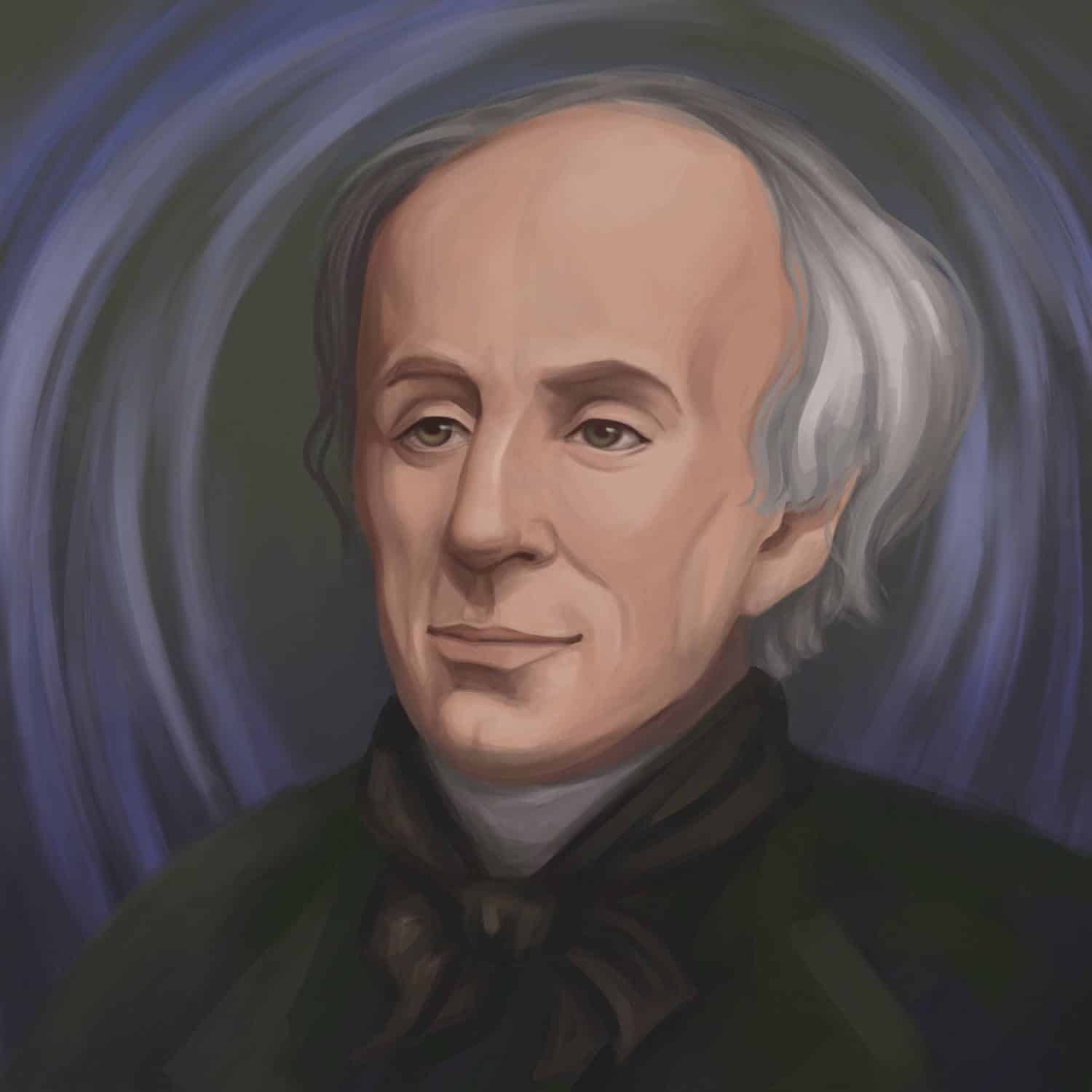Wordsworth was a leading figure in the Romantic poetry movement that focused on life’s daily experience in his writing. He is known for his fascination with the natural world and explores the emotional response one might have from it. His philosophy surrounds the notion that nature can be a restorative and a great source of inspiration. His writing helped propel English literature for years after his death and is widely studied and admired to this day.
Wordsworth’s poetry was controversial in his own time, as some critics found his emphasis on emotion and the individual to be too subjective and lacking in formal structure.

Poetry is the spontaneous overflow of powerful feelings: it takes its origin from emotion recollected in tranquility
William Wordsworth Quote
Early Life
Wordsworth was the second of five children born to parents John Wordsworth and Ann Cookson in the now-historic Wordsworth House in Cockermouth, Cumberland, or modern Cumbria. The home is centered in the Lake District, the area that Wordsworth and many of his contemporaries came to be associated with. He also spent part of his youth in Penrith. He was born a year before his sister, Dorothy Wordsworth. He maintained a strong relationship with her throughout his life. He wrote several poems with his sister in mind or as a character in a broader setting. These include ‘To My Sister.’
William Wordsworth’s father was a legal representative and was often away from home. He died in 1783, having remained distant from his son throughout his life. Despite this, there is evidence to suggest that John Wordsworth encouraged his son to read poems by John Milton, Edmund Spenser, and more. His library was an essential resource in Wordsworth’s development. His mother, Ann, died in 1778, a few years before his father.
After his mother’s death, William’s father sent him away to Hawkshead Grammar School and sent his sister to live in Yorkshire with some relatives. Unfortunately, due to this, the two siblings did not end up seeing each other again for nine years.
Writing Career
Wordsworth’s poetry was first published in The European Magazine in 1787. This same year he started at St. Johns College, Cambridge, where he received a BA in 1791. Around this same period of time, he went on a walking tour of Europe. His first complete poetic publication appeared in 1793 and was titled An Evening Walk. It was followed that same year by Descriptive Sketches.
A few years later, he met fellow poet Samuel Taylor Coleridge with whom he’d publish his best-known collection, Lyrical Ballads. It appeared in 1798 and is today considered to be the start of the Romantic period in English literature. It included poems like ‘Lines Composed a Few Miles Above Tintern Abbey,’ ‘Lines Written in Early Spring,’ and ‘We are Seven.’ Coleridge famously contributed ‘The Rime of the Ancient Mariner.’ The poems in this collection are some of the most important and widely read in the English language.
When the second edition was published two years later, Wordsworth was the only one listed as a contributor. He sought, as explained through the preface, to create poetry that used language “really used by men” and avoided the poetic diction of the previous periods. He famously defined poetry as:
the spontaneous overflow of powerful feelings: it takes its origin from emotion recollected in tranquility.
Around the same period that William Wordsworth and Coleridge published the first edition of Lyrical Ballads, the two traveled to Germany along with Dorothy Wordsworth. Later, Wordsworth started work on ‘The Prelude,’ commonly considered to be his masterpiece, while living with his sister in Goslar. During this period, Wordsworth wrote a great number of poems ranging in themes from death to separation. Additionally, he, along with Coleridge, Robert Southey, and several other poets, became known as the Lake Poets.
In 1807, Coleridge published Poems, in Two Volumes. This collection included ‘Ode: Intimations of Immortality from Recollections of Early Childhood.’ Unfortunately, the collection did not do as well as Lyrical Ballads, the volume for which he’s most commonly cited today.
In 1814, he published ‘The Excursion’, intended as the second part of ‘The Recluse,’ a long philosophical poem. Some believe that Wordsworth’s work declined during this period in part due to the considerable success he’d achieved.
Romantic Poetry
William Wordsworth was one of the greatest romantic poets of all time. One of the most creative spells in his career was from 1799 to 1808, when he moved to Grasmere, on the edge of Lake District. This period of his life has been described as a time of ‘high thinking,’ where he lived with his sister Dorothy. By consistently living in such a location, full of nature, it is easy to see how his poetic style, based on the relationship between human beings and nature, developed fully.
An example of his fascination with nature is seen in his poem ‘I Wandered Lonely as a Cloud,’ where he describes the bliss of solitude in combination with nature. It also shows the synergistic relationship that we have with our environment.
Personal Life and Relationships
In the early 1790s, William Wordsworth fell in love with Annette Vallon, a French woman who gave birth to their daughter, Caroline, in 1792. He met her after visiting the country during the period of the French Revolution. It is said that he became captivated by the Republican movement and revolutionary France as a whole. However, he was forced to return to England without her the following year but continued to support her and their child to the best of his abilities as time passed. Caroline married in 1816, and Wordsworth settled £30 a year on her for the next twenty years.
When Wordsworth and his sister Dorothy returned to France to see Annette in the early 1800s, he broke to news to her that he’d be marrying Mary Hutchinson, a childhood friend. Dorothy lived with the couple and became close friends with Mary. Together, Mary and William Wordsworth had five children; they were John, Dora, Thomas, Catherine, and William. Three of the five died before Mary and William did.
Coleridge and Wordsworth’s relationship fell apart in 1810 due to Coleridge’s opium addiction. Unfortunately, two years later, Wordsworth’s daughter Catherine died at three years old, and then his son Thomas died at six years old only six months later. His daughter Dora died in 1847. This was around the same time that Wordsworth stopped writing.
Wordsworth, Mary, and Dorothy moved to Rydal Mount, Ambleside, in 1813, where the poet spent the rest of his life. He mended his relationship with Coleridge in 1828, six years before the latter’s death. This was the same year that their close friend Charles Lamb, brother to Mary Lamb, also died.
In 1843, Wordsworth was named Poet Laureate of the UK, an honor he initially declined due to his age. Later, he accepted when the prime minister assured him that he’d have to do nothing in the role. He was succeeded by Alfred Lord Tennyson in the year of his death.
Death and The Prelude
William Wordsworth died on April 23rd, 1850, at his home in Rydal Mount from complications associated with pleurisy. His poem, ‘The Prelude,’ was published posthumously by his wife. It is today considered to be the most important achievement of English Romanticism. Read an extract from ‘The Prelude,’ titled ‘Boat Stealing,’ here.
Influence from other Poets
William Wordsworth, like many poets before him, was influenced by other writers and brought elements of their work into his. Some of his greatest influences were Jean-Jacques Rousseau, John Milton, William Shakespeare, and, as previously discussed, his close friend Samuel Taylor Coleridge.
Although Jean-Jacques Rousseau was a philosopher, his ideas ran very close to those of Wordsworth. Rousseau’s focus on the goodness of nature, its inspirational power, and how man is inherently good connected with Wordsworth. This philosophy subsequently made up a large part of his thematic direction.
Wordsworth had a great admiration for John Milton and his use of words, language, and incredible ability to create characters of great complexity. Similarly, William Shakespeare’s poetry had an impact on Wordsworth, again with his generation of characters and capability with powerful imagery.
FAQs
William Wordsworth is best known for his romantic, emotional poetry, which pays particular attention to the connection between the common man and the natural world. The 18th-century poet wrote a number of romantic poems that went on to inspire many poets after him.
Arguably, William Wordsworth’s most famous poem is ‘I Wandered Lonely as a Cloud‘. An extract of his magnum opus, ‘The Prelude,’ the poem is centered around the positive impact that the natural world can have on the mood of a person. But by simply walking in a field of daffodils, he described how his view of the world shifted.
William Wordsworth is actually considered by many scholars and poetry lovers to be the master of Romantic Poetry. His work expertly depicts human emotion, the natural world, and our synergistic relationship with it.
It was said that William Wordsworth suffered from a stomach ailment that eventually halted his poetry altogether in 1801. He would experience chronic indigestion and heartburn that would actually make it painful for him to sit down and write.
William Wordsworth succumbed to a case of pleurisy on April 23rd, 1850, at his home in Grasmere. One of his greatest-ever literary works, ‘The Prelude,’ which he had spent over 50 years working on, was released posthumously and later defined his genius for years to come.


